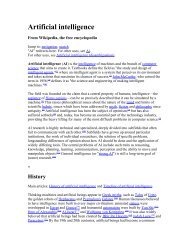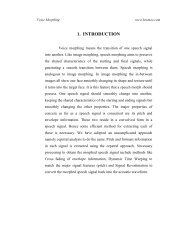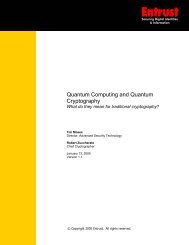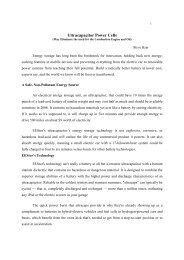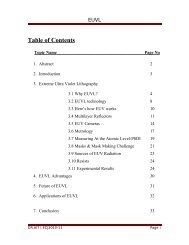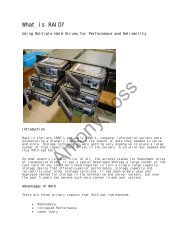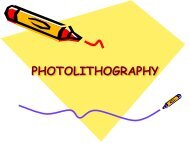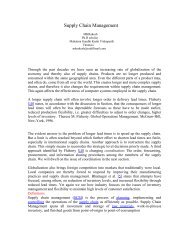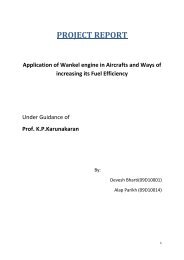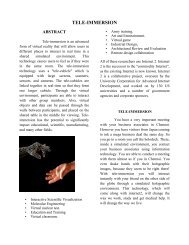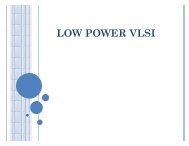Plasmonic organic solar cell.pdf - 123SeminarsOnly
Plasmonic organic solar cell.pdf - 123SeminarsOnly
Plasmonic organic solar cell.pdf - 123SeminarsOnly
You also want an ePaper? Increase the reach of your titles
YUMPU automatically turns print PDFs into web optimized ePapers that Google loves.
2<br />
islands of 12 and 16 nm diameters. The photocurrent response<br />
was increased by about 30% over the whole visible range, and also<br />
in the near-infrared with a factor of 16 at l ¼ 1050 nm. This light<br />
trapping approach, also based on scattering by particles in silicon<br />
devices, clearly allows amplifying the interaction between light<br />
and material. Schaadt et al. [8] reported an engineered enhancement<br />
of optical absorptance and photocurrent in silicon p–n<br />
junction via the excitation of surface plasmon resonances in<br />
spherical Au nanoparticles and suggested their use for improving<br />
performances of photodetectors, imaging arrays and photovoltaics.<br />
Similar studies were carried out with <strong>organic</strong> materials to<br />
enhance light absorptance, subsequently leading to an increase in<br />
the amount of excitons. Stenzel et al. [9] have already demonstrated<br />
in systems ITO/NPs/CuPc/In that incorporating copper or<br />
gold NPs was increasing the photocurrent by a factor of more than<br />
two. This result was then confirmed by Westphalen et al. [10] on<br />
components such as ITO/Ag clusters/ZnPc/Ag in which the exciton<br />
rate was increased resulting in a photocurrent multiplied by a<br />
factor of two. Rand et al. [11] have studied the optical properties of<br />
NPs and have shown that enhancing electromagnetic field by<br />
plasmonic excitation allows to increase conversion efficiency of<br />
tandem <strong>organic</strong> <strong>cell</strong>s by increasing the excitation generation rate.<br />
Their multilayer device ITO/CuPc/PTCBI/silver NPs/CuPc/PTCBI/Ag<br />
consisted of a serial connection of two donor–acceptor heterojunctions<br />
separated by a very thin layer of metallic nanoagregates,<br />
which were used as charge recombination centers.<br />
They also exhibited an increased absorptance by a factor of 2, for<br />
7-nm-thick CuPc single layers including 1-nm-diameter silver NPs<br />
in comparison with single layers without these NPs.<br />
The work presented in this paper aims at studying the<br />
potentiality of this plasmonic technique on <strong>cell</strong>s, of which the<br />
active layer is composed by an interpenetrated donor–acceptor<br />
Ag<br />
1000<br />
nm<br />
0<br />
200nm<br />
1 x 1 µm 2<br />
ARTICLE IN PRESS<br />
50<br />
10<br />
0<br />
1000nm<br />
Fig. 1. Atomic force microscopy (AFM) image of silver nanoparticles spin-coated<br />
on a SiO 2 substrate.<br />
Metallic Nanoparticles<br />
D. Duche et al. / Solar Energy Materials & Solar Cells ] (]]]]) ]]]–]]]<br />
nm<br />
MEH-PPV:PCBM<br />
blend and it also aims at modeling this phenomenon by using a<br />
software based on the Finite Difference Time Domain (FDTD)<br />
method [12]. A bulk heterojunction (BHJ) device has been chosen<br />
because this kind of photoactive material is very promising and,<br />
presently, exhibits the best photovoltaic efficiencies in the field of<br />
<strong>organic</strong> <strong>solar</strong> <strong>cell</strong>s [13].<br />
2. Results and discussion<br />
2.1. Experimental<br />
Photoactive layers were fabricated from an interpenetrated<br />
network of conjugated polymer poly(2-methoxy-5-(2 0 -ethyl-hexyloxy)-1,4-phenylenevinylene)<br />
(MEH-PPV) as electron donor and<br />
fullerene derivative (6,6)-phenyl-C61-butyric-acid-methyl ester<br />
(PCBM) as electron acceptor. These layers were deposited on<br />
silica substrates, after incorporation of silver nanoparticles in<br />
some of the samples.<br />
SiO2 substrates were first sequentially cleaned in an ultrasonic<br />
bath by using acetone and isopropanol, then rinsed with<br />
deionised water, dried in an oven at 120 1C for 30 min and finally<br />
treated with UV-generated ozone. Colloïdal solutions rich in<br />
spherical silver nanoparticles with diameter 40 nm were spincoated<br />
on the silica substrates. These NPs were diluted in 10%wt.<br />
ethylene glycol. The adhesion of NPs on the silica surface was<br />
previously ensured by dip-coating the substrates in an organosilane<br />
(APTMS: 3-aminopropyl trimethoxysilane) in ethanol solution.<br />
This latter step also allows avoiding a too strong aggregation<br />
of the nanoparticles and preventing particle migration in the film.<br />
The parameters of these inhomogeneous metallic deposits have<br />
been adjusted to obtain coalescent deposits as thin as possible,<br />
with a control by atomic force microscopy (AFM) as shown in<br />
Fig. 1. We observe a random array of silver clusters of about<br />
100 nm width and 40 nm height. If the lateral size is higher<br />
than that of one isolated particle, the height is well conserved.<br />
Some substrates, with or without NPs, were then covered by<br />
spin-coating a bulk heterojunction from an anhydrous<br />
chlorobenzene solution of MEH-PPV:PCBM at 1:4 weight ratio<br />
(Fig. 2). The films were spun at 1500 rpm during 1 min. The<br />
thickness of the film was 50 nm, measured by using a mechanical<br />
profilometer.<br />
Spectrophotometric measurements of the reflectance (R) and<br />
the transmittance (T) allows to deduce the values of absorptance<br />
(A) and scattering (S) A+S ¼ 1 R T of these samples in the visible<br />
range (Fig. 3). We clearly observe an improvement of (1 R T)<br />
over a broad spectral range between 375 and 800 nm for stacks<br />
including NPs, with a maximum gain of 50% at 500 nm compared<br />
to those without NPs. In the 375–575 nm spectral domain, the<br />
improvement of (A+S) in the polymer:fullerene heterojunction<br />
including NPs can be mainly attributed to a plasmonic effect<br />
inside the heterojunction while, in the 575–800 nm region, the<br />
improved (A+S) values could be essentially due to the absorptance<br />
and scattering of the NPs themselves.<br />
MEH-PPV:PCBM<br />
Silica substrate Silica substrate<br />
Silica substrate<br />
Fig. 2. Structure of the fabricated samples: (a) silica/silver nanoparticles, (b) silica/MEH-PPV:PCBM 1:4 and (c) silica/silver nanoparticles/MEH-PPV:PCBM 1:4.<br />
Please cite this article as: D. Duche, et al., Sol. Energy Mater. Sol. Cells (2009), doi:10.1016/j.solmat.2009.02.028



